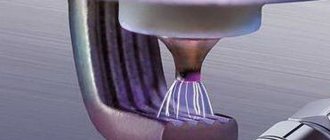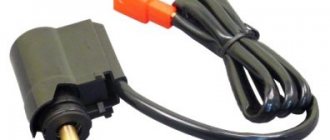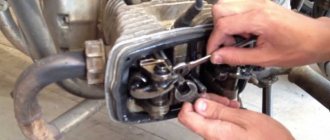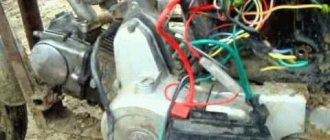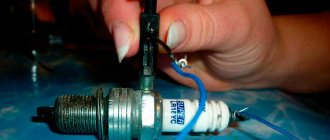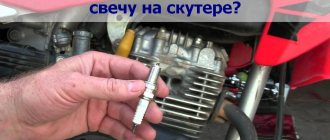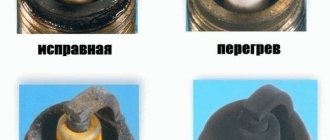002_moto_1211_080
...and a crankshaft position sensor - these are three elements of the injection engine control system, without each of which it will not be able to work (except for a malfunction of the ignition coil on multi-cylinder engines).
Unfortunately, if they fail, you will have to call a tow truck. ...and a crankshaft position sensor - these are three elements of the injection engine control system, without each of which it will not be able to work (except for a malfunction of the ignition coil on multi-cylinder engines). Unfortunately, if they fail, you will have to call a tow truck.
GET IN - IT WILL NOT KILL! Some citizens believe that when repairing or diagnosing electrical wiring, you can get an electric shock. It's in vain. Modern motorcycles (as well as cars) have a voltage of 12 V. This voltage is absolutely safe for humans, for example, if you hold both poles of the battery even with wet hands, you will not feel anything. The only exception is the ignition system, where the voltage in the secondary circuit (armored wire - spark plug) reaches tens of thousands of volts. Here it is better not to grab with wet bare hands, although I have never heard of cases of a person receiving any injury from a high-voltage motorcycle wire. Conclusion: there is no need to be afraid of working with motorcycle electrics. Any household appliance operating on a 220 V network is much more dangerous.
If the engine does not start, it is not at all necessary to immediately “turn the switch” to the ignition system. Moreover, her refusals are extremely rare. Most often, the cause of failure to start is the wrong mixture: either too lean (when, for example, we start a motorcycle in the cold after a long break), or too rich (when on a hot engine the driver forgetfully pulled out the “choke” or after a fall, when gasoline leaks from the float chamber managed to “fill” the cylinder).
It also happens that during many attempts to start the motorcycle, the battery runs low and one malfunction is replaced by another: for example, the mixture may already be normal, but it is no longer possible to produce a spark when the battery voltage is low (and it can drop to 6 V during cranking with the starter) Maybe. In this case, before you disassemble anything, connect another battery to help or, if it is not there, try to start it with a kick.
If flashes do occur in the cylinder, as a rule, the ignition has nothing to do with it. But if the engine is “out of whack”: the starter vigorously turns the crankshaft, the muffler smells of gasoline, and there is not a single flash, it’s time to check the spark.
In principle, little is needed for the engine to work: to supply gasoline (its quantity can vary within quite a wide range - that is why, if, say, a carburetor malfunctions, you can very often select the appropriate mode and get home without touching the unit in an open field) and on time a spark jumping between the spark plug electrodes.
There are rarely any problems with spark timing. So, for example, the protrusion that sets the pulses (for carburetor single-cylinder engines) is located on the generator flywheel and is thus rigidly connected to the crankshaft. Practically, the sensor of its position in injection systems reads pulses from the crankshaft. Thus, the main thing is to make sure that there is a spark at all.
Ignition system with alternator
The gap between the contacts when the piston is at TDC and at the moment of spark formation is adjusted and measured as in a system with battery ignition. Determine the beginning of the contact break using tissue paper or a probe.
The required ignition timing is adjusted by turning the generator.
005_moto_1211_080
To check the spark, you can leave the original spark plug alone and use a spare one.
Otherwise, it is often inconvenient to unscrew it, and sand pours into the cylinders... To check the spark, you can not touch the original spark plug, using a spare one. Otherwise, it is often inconvenient to unscrew it, and sand pours into the cylinders...
The easiest way to do this is without even unscrewing the spark plug, but by using a spare one. Remove the cap from the spark plug in the cylinder, insert a proven working spark plug, turn on the ignition, and turn the shaft (using the starter or kick). It is best if the electrodes of the spark plug are in the shade, so the spark is better visible. If the spark is regular and blue, there is a good chance that the ignition is fine. It remains to make sure that the spark power is sufficient. To do this, insert an electrically conductive object (for example, a screwdriver) into the wire cap and secure its metal part at a distance of 6–8 mm from the “ground” of the motorcycle (cylinder head or engine crankcase). A powerful, regularly sparking spark with a click is a guarantee of the system’s serviceability. If the spark is yellow and jumps out irregularly, check the battery, wires, contacts again (including the breaker and capacitor - on older motorcycles that used a contact ignition system).
If this does not help, and also if there is no spark at all, you will have to look for the fault by replacing parts. The easiest way to start is with a coil and a high-voltage wire. First, let's check the resistance between the low-voltage terminals of the coil (the two “bolts” sticking out of it). It should be very small (from fractions of an ohm to units). Next, we check the resistance between the high-voltage terminal and any of the low-voltage terminals: there should be kilo-ohms there. If you have doubts about the high-voltage wire for testing, you can replace it with any one, as long as it does not pass closer than a couple of centimeters from other parts and wires. This is usually easy to do for a spark test. As a last resort, the ignition coil for checking a carburetor motorcycle can be taken from any similar (non-injection) 12-volt motorcycle or even from a classic Zhiguli.
Easier with multi-cylinder engines. Failure of two independent elements (individual coils or injectors) at once is practically impossible, so to troubleshoot, you can move parts from cylinder to cylinder. And as a last resort, get there on one (or three) by simply turning off the fuel supply to the cylinder without a spark (by unhooking the cable from the carburetor or the connector from the injector).
If replacing the coil, wires and spark plugs does not help, you will have to call a tow truck. It will not be possible to determine the malfunction of the pulse sensor or “brains” (engine control unit) with improvised means, much less repair them. And hardly anyone carries these parts with them (especially an expensive control unit). In addition, checking the pulses produced by the sensor should be carried out using an oscilloscope, since both the shape of the curve and the amplitude are visible on it. And there the signal phase and tenths of a volt play a role. We have already written in detail about the components of the injection system (see “Moto” No. 10–2010).
The photo shows an example of disassembling a generator to replace a faulty pulse sensor of a single-cylinder enduro. The work is not difficult, the sensor is cheap, but is not sold separately - only assembled with generator coils. And this is not cheap at all. Fortunately, there are now non-original kits and sensors on the market: you can try to find a replacement for the original one, preserving the “original” generator windings.
How to get to the generator winding and pulse sensor (using the example of a 1-cylinder enduro 250 cm³):
Types of CDI scheme
A Hall sensor, coil or optocoupler can be used as thyristor ignition sensors. For example, Suzuki scooters use a CDI circuit with a minimum number of elements: the opening of the thyristor in it is carried out by the second half-wave of voltage removed from the charging coil, while the first half-wave charges the capacitor through the diode.
The engine-mounted chopper ignition does not come with a coil that can be used as a charging coil. In most cases, step-up transformers are installed on such motors, which raise the voltage of the low-voltage coil to the required level.
Model aircraft engines are not equipped with a magnet-rotor, since maximum savings in both dimensions and weight of the unit are required. Often a small magnet is attached to the motor shaft, and a Hall sensor is placed next to it. A voltage converter that increases the 3-9V battery to 250V charges the capacitor.
Removing both half-waves from the coil is only possible when using a diode bridge instead of a diode. Accordingly, this will increase the capacitance of the capacitor, which will lead to an increase in the spark.
010_moto_1211_080
After unscrewing the screws, remove the windings and sensor and inspect for damage.
You can measure the resistance of the components and compare it with the recommended one without removing the cover. Remember, as a rule, the control unit receives a signal both from the sensor and from its winding, distributed over the stator power windings. Therefore, it can operate regardless of the functionality of the main power system (the engine can be started even without a battery). After unscrewing the screws, remove the windings and sensor and inspect for damage. You can measure the resistance of the components and compare it with the recommended one without removing the cover. Remember, as a rule, the control unit receives a signal both from the sensor and from its winding, distributed over the stator power windings. Therefore, it can operate regardless of the functionality of the main power system (the engine can be started even without a battery).
Battery ignition
Set gap “a” (for most motorcycles - 0.35 - 0.4 mm) between contacts 3 and 4 of the breaker with the piston position at TDC. To do this, instead of a spark plug, screw in device I for measuring the piston stroke and, loosening the screws 2 securing the fixed contact 3 (anvil), move it away from the movable ion-tact 4 or bring it closer to it.
011_moto_1211_080
The actual culprit of the malfunction (in our case) is the inductive sensor.
There is an internal break in it. Attempts to carefully disassemble it were not very successful: the coil is assembled on a steel bracket, the assembly is filled with durable plastic. The failure occurred suddenly: the running engine stalled and would not start again. The only solution in this case is a tow truck. The actual culprit of the malfunction (in our case) is the inductive sensor. There is an internal break in it. Attempts to carefully disassemble it were not very successful: the coil is assembled on a steel bracket, the assembly is filled with durable plastic. The failure occurred suddenly: the running engine stalled and would not start again. The only solution in this case is a tow truck.
Motorcycle electrical equipment: where does the spark go?
What is BSZ on a motorcycle?
Non-contact microprocessor ignition is simply an indispensable addition for Soviet motorcycles.
Today, not every motorcyclist can afford a foreign-made motorcycle and they have to do their best to modify their old friend. Those who have installed such an ignition on their motorcycle have already experienced a lot of advantages. Needless to say, starting the same IZH motorcycle is sometimes very difficult. The reason often lies in the original contact ignition. It is simply impossible to accurately adjust it and therefore it would be best to replace it with a non-contact system. This pleasure will cost about fifty US dollars, but it is well worth the money. You will no longer have difficulty starting the engine.
You can install such an ignition yourself in a garage. The delivery kit includes a diagram and installation instructions. After you install such an ignition system, you will notice that interruptions in engine operation will disappear and the cylinders will begin to work synchronously. The spark will be supplied simultaneously to two cylinders. This allows you to stabilize the operation of the motor.
As for fuel consumption, it will decrease and not slightly, since now all the gasoline will burn, and not just fly out into the chimney or fill the spark plugs. This ignition system allows you to start the engine even in the winter season. There will no longer be a need to constantly monitor the fuel level. Such an ignition system will itself calculate the advance angle. Using a switch, it will analyze the load on the motor and make appropriate adjustments to sparking.
If you are tired of problems with contact ignition, now you have an excellent opportunity to get rid of them. A contactless ignition system can greatly improve the performance of your motorcycle’s power unit.
Advantages of BSZ over KSZ
While writing the article, I sat and thought and thought, and still did not come to the conclusion of what exactly is the main advantage of BSZ; for me, all the advantages listed below are the main ones and are equal to each other.
— High stability of engine operation (synchronous operation of the cylinders, strictly in turn)
— Frisky review of the throttle
— Better engine thrust (which allows you to easily use the largest drive stars without difficult acceleration!)
— Candles “live” four times longer than on KSZ (I’ll write about this separately below)
— Less well-known “snot” from Java mufflers (since fuel and oil are burned much better)
— Longer service life of all crank bearings (as there is less extraneous detonation and vibration)
— Less fuel consumption (since it burns better, the carburetor must be adjusted to a lower fuel supply)
